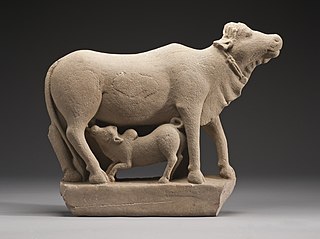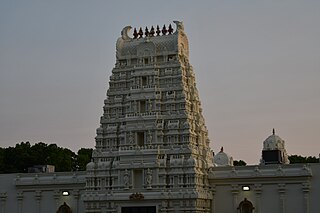
In livestock agriculture and the meat industry, a slaughterhouse, also called an abattoir, is a facility where livestock animals are slaughtered to provide food. Slaughterhouses supply meat, which then becomes the responsibility of a meat-packing facility.

Lakshmi also known as Shri, is one of the principal goddesses in Hinduism. She is the goddess of wealth, fortune, power, beauty, fertility and prosperity, and associated with Maya ("Illusion"). Along with Parvati and Saraswati, she forms the Tridevi of Hindu goddesses.

Ashland is a town in Middlesex County, Massachusetts, United States. It is part of the MetroWest region. The population was 18,832 at the 2020 United States census.

There are varying beliefs about cattle in societies and religions.

Kamadhenu, also known as Surabhi, is a divine bovine-goddess described in Hinduism as the mother of all cows. She is a miraculous cow of plenty who provides her owner whatever they desire and is often portrayed as the mother of other cattle. In iconography, she is generally depicted as a white cow with a female head and breasts, the wings of a bird, and the tail of a peafowl or as a white cow containing various deities within her body. Kamadhenu is not worshipped independently as a goddess. Rather, she is honored by the Hindu veneration of cows, who are regarded as her earthly embodiments.

Cow dung, also known as cow pats, cow pies or cow manure, is the waste product (faeces) of bovine animal species. These species include domestic cattle ("cows"), bison ("buffalo"), yak, and water buffalo. Cow dung is the undigested residue of plant matter which has passed through the animal's gut. The resultant faecal matter is rich in minerals. Color ranges from greenish to blackish, often darkening soon after exposure to air.

A Mangalsutra, or Tali, is a necklace that the groom ties around the bride's neck in the Indian subcontinent, in a ceremony called Mangalya Dharanam within a Hindu wedding. The necklace serves as a visual marker of status as a married Hindu woman.

Tihar is a five-day Hindu festival of Diwali celebrated in Nepal and the Indian regions of Sikkim and Gorkhaland, which host a large number of ethnic Nepali Indians.

Howard F. Lyman is an American farmer and animal rights activist known for promoting vegan nutrition and organic farming. In 1997 he was awarded the Peace Abbey Courage of Conscience Award for his leadership in the animal rights movement.

Cincinnati Freedom, also known as Charlene Moo-ken, after Cincinnati Mayor Charlie Luken, was a 1,050-pound Charolais cow that gained fame when, on February 15, 2002, she leaped over a six-foot fence at Ken Meyers Meats, a Camp Washington (Cincinnati) slaughterhouse, and escaped. After eluding the traps and tranquilizer darts of SPCA officials and police officers for 11 days, she was finally captured just after midnight on February 26 in Clifton, Cincinnati, Ohio. She lived out the rest of her life at Farm Sanctuary's New York Shelter in Watkins Glen, New York, where she was particularly popular with animal rights activists and animal lovers.

Shrutakirti is a princess featured in the Hindu epic Ramayana. She is the daughter of King Kushadhvaja and queen Chandrabhaga. She is the wife of Shatrughna, the younger brother of Rama. Shrutakirti is considered to be an incarnation of the disc of the goddess Lakshmi.

Ganga is the personification of the river Ganges, who is worshipped by Hindus as the goddess of purification and forgiveness. Known by many names, Ganga is often depicted as a fair, beautiful woman, riding a divine crocodile-like creature called the makara.
Women have played a central role in animal advocacy since the 19th century. The animal advocacy movement – embracing animal rights, animal welfare, and anti-vivisectionism – has been disproportionately initiated and led by women, particularly in the United Kingdom. Women are more likely to support animal rights than men. A 1996 study of adolescents by Linda Pifer suggested that factors that may partially explain this discrepancy include attitudes towards feminism and science, scientific literacy, and the presence of a greater emphasis on "nurturance or compassion" amongst women. Although vegetarianism does not necessarily imply animal advocacy, a 1992 market research study conducted by the Yankelovich research organization concluded that "of the 12.4 million people [in the US] who call themselves vegetarian, 68% are female, while only 32% are male".
The cow protection movement is a predominantly Indian religious and political movement aiming to protect cows, whose slaughter has been broadly opposed by Hindus, Buddhists, Jains, Zoroastrians and Sikhs. While the opposition to slaughter of animals, including cows, has extensive and ancient roots in Indian history, the term refers to modern movements dating back to colonial era British India. The earliest such activism is traceable to Namdhari (Kooka) Sikhs of Punjab who opposed cow slaughter in the 1860s. The movement became popular in the 1880s and thereafter, attracting the support from the Arya Samaj founder Swami Dayananda Saraswati in the late 19th century, and from Mahatma Gandhi in the early 20th century.

Cattle slaughter in India, especially cow slaughter, is controversial because of cattle's status as endeared and respected living beings to adherents of Dharmic religions like Hinduism, Jainism, Buddhism and Sikhism; while being an acceptable source of meat for Muslims, Christians and Jews. Cow slaughter has been shunned for a number of reasons, specifically because of the cow's association with the god Krishna in Hinduism, and because cattle have been an integral part of rural livelihoods as an economic necessity. Cattle slaughter has also been opposed by various Indian religions because of the ethical principle of Ahimsa (non-violence) and the belief in the unity of all life. Legislation against cattle slaughter is in place throughout most states and territories of India.
Animal welfare and rights in India regards the treatment of and laws concerning non-human animals in India. It is distinct from animal conservation in India.
Cattle theft, more commonly cattle raiding or cattle lifting, is a property crime in India. In the ancient and medieval era India texts, stealing cattle is described as a crime and sin, a motif that appears in Hindu mythologies.

Joseph Dominic Armstrong, known professionally as Joey Carbstrong, is an Australian animal rights activist. A former criminal, he has since become an advocate for animal liberation and veganism through social media and public speaking engagements, as well as debates and various televised interviews.

The Sri Lakshmi Temple in Ashland, Massachusetts, also known as the New England Hindu Temple, Inc. (NEHTI), is New England’s first traditional Hindu temple. The temple was inaugurated in 1990 by priests from India, the United States, and Britain. Following the inauguration in 1990, the temple was expanded in 2005 and 2018. The central deity worshiped is Lakshmi, who Hindus consider as the Goddess of Prosperity.















